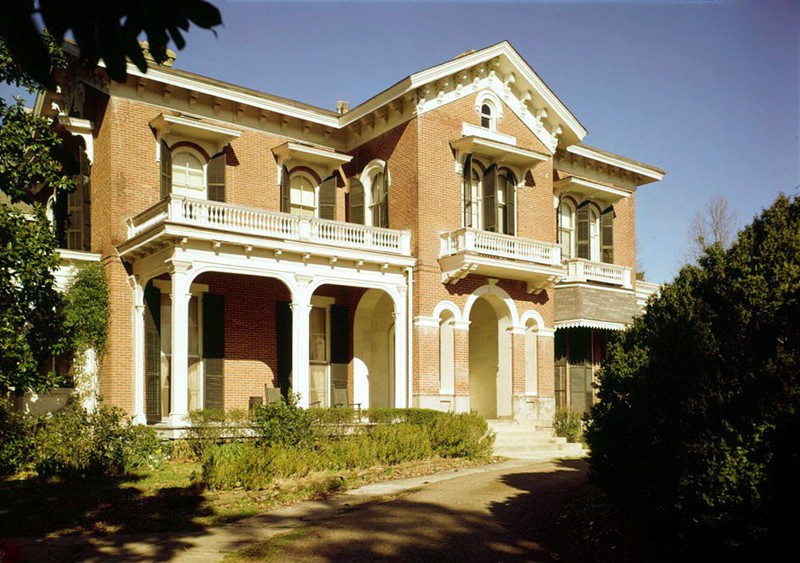Ammadelle
Introduction
Text-to-speech Audio
Built by Thomas E. B. Pegues between 1859 and 1861, the house, boasting the Italianate style, is a testament to the architectural talents of designer Calvert Vaux. After surviving the crossfires of the Civil War, the home was sold multiple times throughout the years. Today, the home is listed on the National Register of Historic Places and thanks to the efforts of the current homeowners the house and seven acres of land is under the protection of the Mississippi Department of Archives and History.
Images
Ammadelle was built in 1861 and is an excellent example of Italianate architecture designed by Calvert Vaux.

Backstory and Context
Text-to-speech Audio
First homeowner of Ammadelle Thomas E. B. Pegues reached out to the famed architect Calvert Vaux, who resided in New York. After Vaux showed Pegues his work along the Hudson River, Pegues hired him to design him a Tuscany inspired home in Oxford, Mississippi. The bricks used to make the home were crafted by Pegues' slaves. Due to the Civil War, construction on the home was paused, and the back balcony and wine cellar that appear in Vaux's original drawings were never added. Interestingly, the home had a secret room in which Confederate soldiers hid during the war, and the kitchen was in the house itself and not in a separate structure. This was a common practice back then to prevent the spread of fires.
The following description of the home is from the National Register of Historic Place nomination form:
The following description of the home is from the National Register of Historic Place nomination form:
Built of red brick with white Italianate trim and Black shutters, the house has an irregular plan. Porches on the east (front) and north provide shaded, open, outdoor rooms. The front entrance is deeply recessed and opens into a reception hall connecting through great double sliding doors to the stair hall at the rear. To the right are double parlors; through the rear parlor one can enter a small library. To the left is the dining room with a small conservatory at the south end.
A sequence of pantries and halls leads to the kitchen in a one-story wing. There is one bedroom on the first floor rear and five on the second floor The dominant effect of the interiors is one of spaciousness and solidity. Vaux'details areas well ordered as the overall scheme. Vaux was both architect and landscape architect. Appropriately, the 7-acre site is developed with picturesque curves defining lawns and plantings.
Sometime during the 1880s, a man by the name of Charles Roberts purchased the home and called it "Edgecomb", though it is unclear how he came up with that name. It was re-named Ammadelle in 1898 by the next owner, Bem Price, who came up with the estate's new name by combining his sister's name Amma and his wife's name Delle. After Price's passing in 1903, Delle resided in the home until it was passed to the Price's niece Minnie Sively. After Silvey, the home was owned by David Neilson, and then, John F. Tatum. The Tatum family has resided there since the 1960s and have been instrumental in preserving the home.
Sources
Goeldner, Paul. "Ammadelle." National Park Service - National Register of Historic Places Nomination Form. May 30, 1974. http://pdfhost.focus.nps.gov/docs/NRHP/Text/74001064.pdf.
Mayfield, Jack Lamar. "Oxford’s Olden Days: Ammadelle – Money, Calvert Vaux and William Turner." June 22, 2015. http://hottytoddy.com/2014/07/01/oxfords-olden-days-ammadelle-money-calvert-vaux-and-william-turner.
Photo: Jack Boucher, Photographer
http://memory.loc.gov/cgi-bin/displayPhoto.pl?path=/pnp/habshaer/ms/ms0200/ms0262/color&topImages=57...
Mayfield, Jack Lamar. "Oxford’s Olden Days: Ammadelle – Money, Calvert Vaux and William Turner." June 22, 2015. http://hottytoddy.com/2014/07/01/oxfords-olden-days-ammadelle-money-calvert-vaux-and-william-turner.
Photo: Jack Boucher, Photographer
http://memory.loc.gov/cgi-bin/displayPhoto.pl?path=/pnp/habshaer/ms/ms0200/ms0262/color&topImages=57...
